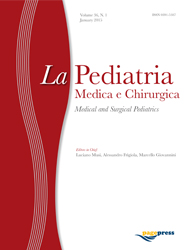Articles
Vol. 40 No. 2 (2018)
Transscrotal orchidopexy for palpable cryptorchid testis: follow-up and outcomes

Publisher's note
All claims expressed in this article are solely those of the authors and do not necessarily represent those of their affiliated organizations, or those of the publisher, the editors and the reviewers. Any product that may be evaluated in this article or claim that may be made by its manufacturer is not guaranteed or endorsed by the publisher.
All claims expressed in this article are solely those of the authors and do not necessarily represent those of their affiliated organizations, or those of the publisher, the editors and the reviewers. Any product that may be evaluated in this article or claim that may be made by its manufacturer is not guaranteed or endorsed by the publisher.
Received: 13 January 2018
Accepted: 3 August 2018
Accepted: 3 August 2018
2380
Views
975
Downloads
419
HTML






